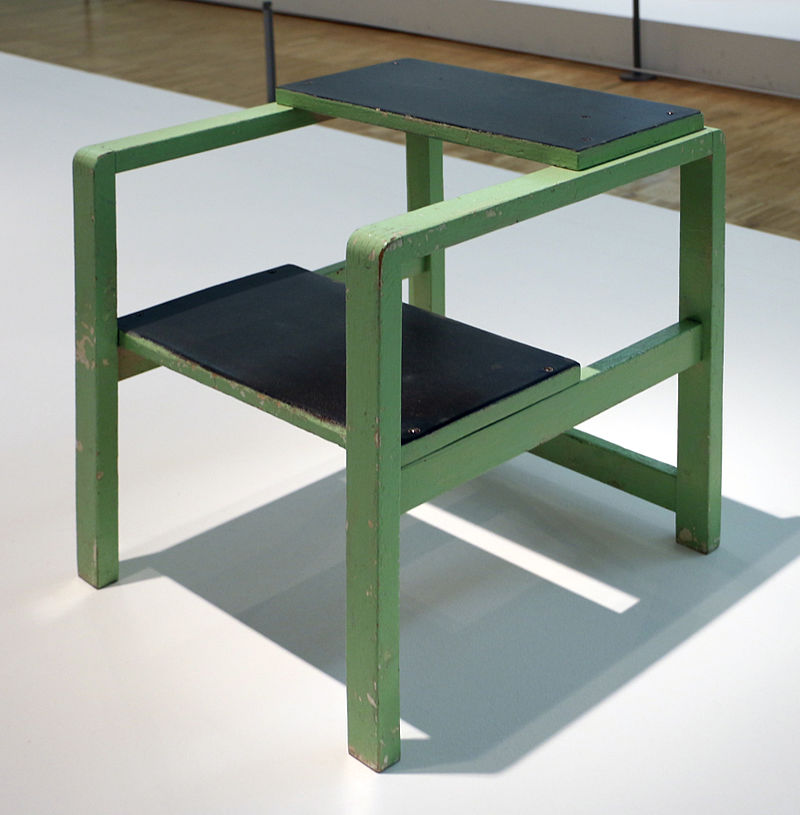The Bauhaus Movement, which emerged in Germany during the early 20th century, has left an indelible mark on modern design and architecture. With its avant-garde approach, the Bauhaus not only challenged conventional artistic and architectural norms but also paved the way for innovative design principles that continue to influence contemporary aesthetics. In this comprehensive article, we will delve into the multifaceted impact of the Bauhaus Movement on modern design and architecture, exploring its origins, key principles, notable figures, and lasting legacy.
History of The Bauhaus
1. Weimar
The history of Bauhaus in Weimar is a pivotal chapter in the story of this influential art and design school. Weimar was the birthplace of the Bauhaus Movement, and it is where the school was first established, setting the stage for its subsequent evolution and impact on modern art, architecture, and design.
Founding of the Bauhaus:
The Bauhaus School was founded in Weimar, Germany, in 1919 by architect Walter Gropius. It emerged in the aftermath of World War I and amid the political and cultural upheaval of the Weimar Republic. Gropius envisioned the Bauhaus as an institution that would bring together artists, craftsmen, and architects to create a new approach to design and art education.
In addition to learning about the Bauhaus Movement, learn about the journey of Deconstructivism Architecture in NYC. Visit New York’s Architectural Rebellion – A Journey Through a Deconstructivism Design.
A Fusion of Arts and Crafts:
At the core of the Bauhaus philosophy in Weimar was the idea of uniting the arts and crafts. Gropius aimed to break down the traditional divisions between fine arts, such as painting and sculpture, and applied arts, including architecture and industrial design. This interdisciplinary approach was central to the Bauhaus curriculum.
View this post on Instagram
Influential Faculty and Students:
Weimar attracted a remarkable group of artists and teachers, including Wassily Kandinsky, Paul Klee, Lyonel Feininger, and Johannes Itten. Their innovative ideas and artistic contributions played a significant role in shaping the Bauhaus curriculum and aesthetic. Students, too, played an essential role, as many of them would go on to become influential figures in their respective fields.
The “Bauhaus Manifesto”:
In 1919, Gropius published the “Bauhaus Manifesto,” outlining the school’s principles and goals. This document articulated the vision of the Bauhaus as a place where artists and craftsmen could work together to create functional and aesthetically pleasing designs for the modern world.
Architectural and Design Experiments:
The Weimar period of the Bauhaus saw a focus on architectural and design experiments. Gropius himself designed the Bauhaus building in Weimar, which became an iconic example of modernist architecture. The school also produced groundbreaking designs in areas such as furniture, typography, and stage design.
Political and Financial Challenges:
The Bauhaus faced political and financial challenges during its time in Weimar. It was seen as a radical and experimental institution by some, which led to tensions with more conservative elements in the city. In 1925, the school faced budget cuts and political pressure, prompting a move to Dessau.
Legacy and Influence:
Despite its relatively short stay in Weimar, the Bauhaus left an enduring legacy in the city and beyond. The architectural innovations and design principles developed during this period continued to influence modernist movements in Germany and worldwide. The Bauhaus’s emphasis on the integration of art, technology, and industry also laid the groundwork for the school’s later developments in Dessau and Berlin.
2. Dessau
The history of Bauhaus in Dessau marks a significant chapter in the development and influence of this iconic art and design school. After its initial establishment in Weimar, the Bauhaus moved to Dessau in 1925, where it continued to evolve and make lasting contributions to modern architecture and design.
Reasons for the Move to Dessau:
The decision to relocate the Bauhaus from Weimar to Dessau was influenced by several factors. One primary reason was financial constraints and political pressure in Weimar. Walter Gropius, the founder of the Bauhaus, believed that Dessau offered a more progressive and supportive environment for the school’s innovative ideas.
The New Bauhaus Building in Dessau:
One of the most iconic aspects of the Bauhaus in Dessau is the new building designed by Walter Gropius himself. Completed in 1926, the Bauhaus Dessau building is a masterpiece of modernist architecture. It embodies the Bauhaus principles of functionality, simplicity, and the integration of art and technology. The building’s design emphasized transparency, with large glass windows and open spaces, reflecting the school’s commitment to experimentation and collaboration.
Teaching and Curriculum:
In Dessau, the Bauhaus curriculum continued to emphasize the fusion of arts and crafts. The school offered workshops in various disciplines, including architecture, woodworking, metalworking, textiles, and typography. The faculty included influential figures like László Moholy-Nagy and Josef Albers, who made significant contributions to Bauhaus pedagogy.
Innovations in Design:
The Dessau period saw remarkable innovations in design. The Bauhaus produced iconic furniture pieces, such as Marcel Breuer’s Wassily Chair and Ludwig Mies van der Rohe’s Barcelona Chair. These designs exemplified the school’s commitment to functional and minimalist aesthetics, influencing modern furniture design for decades to come.
The Bauhaus Stage:
Another notable aspect of the Dessau Bauhaus was its emphasis on stage design and theater. Oskar Schlemmer, a prominent Bauhaus instructor, developed his celebrated “Triadic Ballet” during this period, showcasing the school’s innovative approach to performance art and stage design.
Challenges and Closure:
Despite its contributions and growing international recognition, the Bauhaus faced challenges during its time in Dessau. The school’s progressive ideas and artistic experiments drew criticism from conservative elements, leading to tensions with local authorities. In 1932, due to financial difficulties and political pressures, the Bauhaus was forced to close its doors in Dessau.
Legacy and Influence:
The Dessau period of the Bauhaus left an indelible mark on the fields of architecture, design, and education. The principles and innovations developed during this time continue to influence modernist and contemporary design worldwide. The Bauhaus Dessau building itself stands as a symbol of modernist architecture and is now a UNESCO World Heritage site, attracting visitors from around the globe.
3. Berlin
The history of Bauhaus in Berlin represents the final chapter in the journey of this influential art and design school. After its initial establishment in Weimar and a subsequent move to Dessau, the Bauhaus found its last home in Berlin before being ultimately closed by the Nazi regime in 1933.
The Move to Berlin:
In 1932, as political pressures and financial difficulties mounted, the Bauhaus relocated once again, this time to Berlin. Walter Gropius had resigned as the director in 1928, and Ludwig Mies van der Rohe had taken his place. The move to Berlin was seen as a last attempt to secure the school’s survival in the face of increasing threats from the Nazi Party.
The Berlin Years:
The Bauhaus in Berlin continued to offer a range of workshops and courses in art, design, and architecture. Mies van der Rohe, known for his “less is more” philosophy, led the school during this period and emphasized architectural design. He sought to strengthen the Bauhaus’s architectural program and bring it to the forefront of modern design.
Influence on Architecture:
The Berlin Bauhaus continued to produce influential architectural designs and concepts. Mies van der Rohe’s famous Tugendhat House and Barcelona Pavilion are prime examples of Bauhaus-inspired architecture. These structures showcased the school’s commitment to functionalism, minimalism, and the innovative use of materials.
Closure by the Nazi Regime:
The Berlin period of the Bauhaus was short-lived due to the rise of the Nazi regime. In 1933, the Nazis’ anti-modernist and anti-Semitic ideologies led to the forced closure of the Bauhaus. The school’s faculty and students faced persecution, and its buildings and workshops were shut down.
Legacy and Influence:
Despite its premature closure in Berlin, the Bauhaus’s influence continued to spread globally. Many of its former faculty and students emigrated to other countries, including the United States, where they played pivotal roles in shaping modernist architecture and design. The principles and ideas of the Bauhaus, including the integration of art, technology, and industry, continued to reverberate in the design world.
View this post on Instagram
Reverence for Bauhaus Ideals:
The Bauhaus’s legacy was preserved and celebrated in the decades that followed. Its innovative pedagogy, architectural innovations, and commitment to functional design became touchstones for modern design education and practice. Numerous exhibitions, publications, and retrospectives have paid tribute to the enduring impact of the Bauhaus Movement.
The Bauhaus Archive:
In 1960, the Bauhaus Archive was established in West Berlin as a research institution dedicated to preserving the history and legacy of the Bauhaus. It houses an extensive collection of documents, artworks, and artifacts related to the school and its members, serving as a valuable resource for researchers and enthusiasts.
Key Principles of Bauhaus
Form Follows Function
One of the fundamental tenets of the Bauhaus Movement is the principle that “form follows function.” This concept, rooted in industrial design, emphasizes the importance of creating objects and buildings that prioritize functionality and utility. Bauhaus designers believed that the form of an object should directly result from its intended purpose, giving rise to minimalist and streamlined designs that have become emblematic of modernism.
Unity of Art and Craft
The Bauhaus sought to break down the traditional hierarchy that separated fine arts from applied arts and crafts. Students at the school were encouraged to explore a wide range of media, from painting and sculpture to textiles and architecture. This interdisciplinary approach fostered creativity and innovation, leading to a more holistic understanding of design.
Industrial Materials and Mass Production
In line with its emphasis on functional design, the Bauhaus embraced the use of industrial materials and production techniques. This marked a departure from the ornate and labor-intensive craftsmanship of the past. Bauhaus designers championed mass production as a means to make well-designed objects accessible to a broader audience, thereby democratizing design.
Notable Figures of the Bauhaus Movement
1. Walter Gropius
As the founder of the Bauhaus School, Walter Gropius played a pivotal role in shaping the movement’s philosophy and curriculum. Gropius’s architectural designs, characterized by clean lines and innovative use of materials, set the tone for the Bauhaus aesthetic. His vision for the school as a breeding ground for creative collaboration laid the foundation for its enduring legacy.
2. Wassily Kandinsky
Wassily Kandinsky, a renowned Russian painter, joined the Bauhaus faculty in 1922. His work and teachings at the school explored the relationship between color, shape, and emotion. Kandinsky’s influential theories on abstract art and color theory had a profound impact on the development of modern art and design.
3. Ludwig Mies van der Rohe
Ludwig Mies van der Rohe succeeded Gropius as the director of the Bauhaus in 1930, during the school’s final years in Berlin. Mies, known for his famous dictum “less is more,” emphasized simplicity, structural integrity, and the innovative use of materials in his architectural designs. His influence extended beyond the Bauhaus era, shaping modernist architecture worldwide.
The Bauhaus Legacy in Architecture
The International Style
The teachings and architectural experiments conducted at the Bauhaus greatly contributed to the emergence of the International Style in architecture. Characterized by functionalism, geometric shapes, and the use of modern materials like steel and glass, the International Style became synonymous with the modernist movement. Bauhaus-trained architects, including Mies van der Rohe, helped spread this style globally.
Bauhaus-Inspired Buildings
Numerous Bauhaus-inspired buildings and architectural projects continue to stand as iconic examples of modernist design. The Barcelona Pavilion designed by Mies van der Rohe for the 1929 International Exposition in Spain and the Farnsworth House in Illinois are prime examples of Bauhaus-influenced architecture. These structures showcase the use of open spaces, glass walls, and minimalistic aesthetics.
Bauhaus in Product and Graphic Design
Bauhaus Furniture
Bauhaus principles profoundly influenced furniture design, giving rise to iconic pieces such as the Wassily Chair by Marcel Breuer and the Barcelona Chair by Mies van der Rohe. These designs exemplify the marriage of form and function, with clean lines, geometric shapes, and the use of industrial materials.
Graphic Design and Typography
The Bauhaus also made significant contributions to graphic design and typography. Herbert Bayer, a Bauhaus student and later a teacher, developed the Bauhaus typeface, which remains a classic example of sans-serif typography. The school’s focus on clarity and legibility in typography revolutionized graphic design and continues to influence modern visual communication.
The Legacy Lives On
Bauhaus in Contemporary Architecture
The Bauhaus Movement’s legacy endures in contemporary architecture, where architects and designers still draw inspiration from its principles. Sustainable design, open floor plans, and the use of natural light are all concepts that owe a debt to the Bauhaus.
Bauhaus in Art and Design Education
The pedagogical approach of the Bauhaus, emphasizing hands-on learning, experimentation, and the unity of art and craft, continues to shape art and design education today. Many art schools and institutions incorporate Bauhaus principles into their curricula, ensuring that the movement’s legacy lives on through future generations of designers and artists.
Conclusion
The Bauhaus Movement’s impact on modern design and architecture is immeasurable. Its emphasis on functionality, interdisciplinary collaboration, and the use of industrial materials has left an indelible mark on the way we conceive and create in the 21st century. From iconic buildings to minimalist furniture and innovative typography, the Bauhaus legacy continues to shape our contemporary design landscape, serving as a testament to the enduring power of its ideas and principles. As we navigate an ever-evolving world of design, the Bauhaus Movement remains a timeless source of inspiration and innovation.



